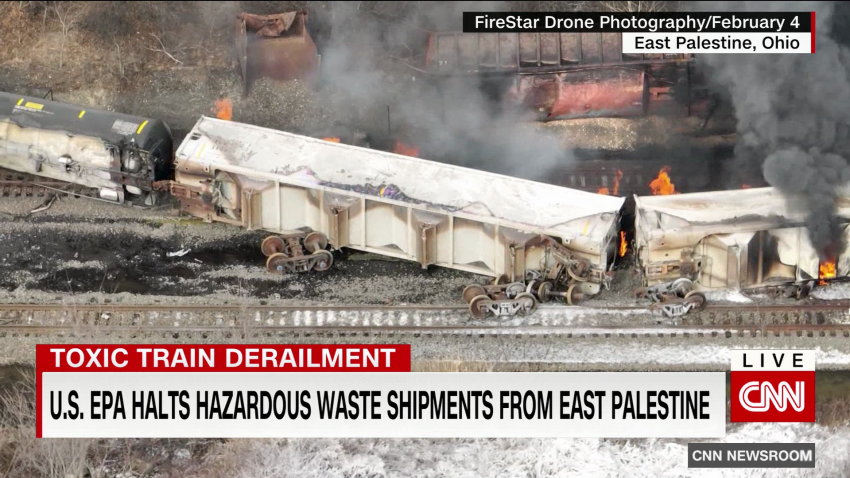A mobile lab monitoring for air pollution at the site of the Norfolk Southern train derailment in East Palestine, Ohio, found one potential chemical of concern at higher levels than normal, a team of scientists from Carnegie Mellon University and Texas A&M said at a briefing on Friday. Researchers said it’s not yet clear what impact the chemical acrolein could be having on residents’ health.
The US Environmental Protection Agency gave the all clear for residents to return home shortly after the February 3 derailment and controlled burn that followed. The agency, along with local and state environmental experts, has been taking samples from the air, ground, water and from residents’ homes. Many residents have reported worrisome health symptoms in the weeks since the derailment, including rashes and headaches.
Information in the new analysis was collected on February 20 and 21, university researchers said. The mobile lab, located in a van, sucks in air from above the driver’s head as it slowly drives around public roads. It collects data points every second, the team said, and the unit has sensitive equipment that can measure pollution in the parts per billion; they can identify even minute pollutant concentrations that may otherwise be untraceable.
The lab found that values of benzene, toluene, xylenes and vinyl chloride were below the minimal risk levels for intermediate exposures as set by the Agency for Toxic Substances and Disease Registry.
The team said Friday there were no “hot spots” detected by their mobile sampling, and the analysis corroborates the data collected by the US Environmental Protection Agency between February 8 and February 22.
“We didn’t see any hotspots, which I think is probably a positive takeaway,” said Albert Presto, an associate research professor of mechanical engineering at Carnegie Mellon’s Wilton E. Scott Institute for Energy Innovation who is working on the university’s chemical monitoring effort in East Palestine. “I would say there’s a need for further investigation and for continued sampling” because of potential risk, particularly from the chemical acrolein.
Acrolein was also below the minimal risk level, but it was the one chemical that was notably high, the researchers said. When compared with levels in downtown Pittsburgh, levels in the East Palestine area ranged from five times lower to three times higher on February 20.
Acrolein is used to control plants, algae, rodents and microorganisms. It is a clear liquid at room temperature and it is toxic; it can cause inflammation and irritation of the skin, respiratory tract and mucous membranes, according to the US Centers for Disease Control and Prevention.
While acrolein was not on the list of chemicals carried on the derailed train cars, it can be created during the combustion of fuels, wood and plastics, according to the International Agency for Research on Cancer.
The Texas A&M and Carnegie Mellon researchers say the test method the EPA is using to measure acrolein on the scene has a limit that is too high to pick up levels relevant to health.
“The current methodology used by the EPA is not very sensitive and acrolein is a difficult chemical to evaluate,” said Dr. Ivan Rusyn, director of the Texas A&M University Superfund Research Center, part of the team that did the analysis. “This is potentially not the only concern. You need to look broader at other types of contaminants, and this is what mobile laboratory allows one to do.”
The university researchers had previously shared results from an initial analysis of the EPA’s data that suggested that nine of the dozens of chemicals that the agency has been monitoring are higher than would normally be found in the area. The researchers said these could potentially be a problem for residents’ health in the long term.
CNN has reached out to the EPA for comment about the new analysis. On Monday, an agency spokesperson told CNN the agency’s air monitoring data shows that levels of monitored chemicals “are below levels of concern for adverse health impacts from short-term exposures.” The agency did not expect chemicals to remain at high levels in the area, but said it is “committed to staying in East Palestine and will continue to monitor the air inside and outside of homes to ensure that these levels remain safe over time.”
Rusyn said they are pleased that the EPA has said it is also deploying a mobile lab to do additional testing. Scientists will need to continue to monitor acrolein and other compounds in the area to determine if exposures persist, he said.
Get CNN Health's weekly newsletter
Sign up here to get The Results Are In with Dr. Sanjay Gupta every Tuesday from the CNN Health team.
“The reason to continue testing – at least at some intervals after the event – in establishing those trends, part of that is really for communication purposes, to really reassure the residents that you know the level and explain to them where the levels after the disaster were as compared to some sort of a baseline,” Rusyn said.
Rusyn said it is too soon to know whether elevated levels are having an impact on residents’ health.
“We can’t draw to many conclusions about potential health effects because the levels that are being reported are below detection limits, but the health thresholds are also below the detection limit. So there are additional or different methods that are more sensitive, they take more time, and they are more elaborate, and we’re hoping that the agencies will use some of those methods, as well, in the future,” Rusyn said.




